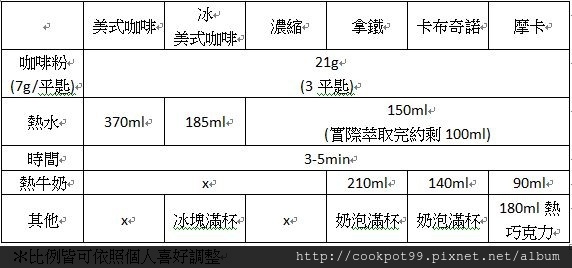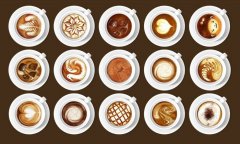Coffee type large analysis coffee shop common coffee type introduction and extraction cup brewing ratio

Professional coffee knowledge exchange more coffee bean information please follow the coffee workshop (Wechat official account cafe_style)
Introduction and nomenclature of various rare coffee varieties
Love to eat treasure love to drink lattes! Sometimes there is no espresso machine around. I found that I soak it thicker with an extraction cup and turn it into coffee milk with milk, which is also very mellow!
Baoer's colleagues also have a lot of coffee control, some only drink American style, some are fond of concentration.
This variety of names may confuse coffee laymen. This small talk will teach you the most common types of coffee! I also look forward to becoming a coffee master with you.
-the following is just a proportional reference! The taste of each kind of coffee can be adjusted according to personal preference! -
Cafe Americano
The recommended powder-to-water ratio for American coffee is 1:10, which means 10 grams of coffee powder with 100ml hot water, the thickness can be adjusted according to personal preference. If you are using an espresso machine, a serving of espresso is about 30ml. It is recommended to add hot water and dilute it to 10 times the capacity, that is, 300ml.
The product is in-depth, you may want to change a little. From the purest American coffee to lattes, mochas, cappuccinos and other fields, the "bridge" is the cup of espresso-Espresso.
Espresso Espresso
A good Espresso has three elements: the grindability of the coffee powder, the formula of the coffee beans, and the water temperature when brewing. When brewing a cup of Espresso, the flow rate of the coffee liquid should be about 23 seconds. If the time is long and the flow rate is slow, it means that the coffee powder is too fine, or the pressure is too tight, which may lead to over-extraction (excessive extraction). If the flow rate is less than 15 seconds, it means that the coffee powder is too coarse and will lead to insufficient extraction. The water temperature is 93 °C, which can be adjusted according to the baking degree. Generally speaking, the water temperature of shallow roasted coffee can be as high as 95 °C and that of deep roasted coffee can be reduced to 91 °C. As for the quality of beans, you can find a reputable manufacturer to check for you; naturally, you need an espresso machine to extract under pressure during the brewing process in order to show the consistency, purity and aroma of Espresso.
The brewing method of Espresso is to press the hot water at 93 °C through the coffee powder at 8-9 atmospheric pressure, quickly extract the essence of the coffee, shorten the contact time between the hot water and the coffee powder, reduce the caffeine left in the coffee liquid, but retain the coffee oil foam (Crema).
There are three common proportional concentrations of Espresso: Single, Double and Ristretto. Single uses about 9 grams of coffee powder to flush out 30ml's coffee; Double, as the name implies, is twice the capacity of Single, using 18 grams of coffee powder to flush out 60ml coffee. As for Ristretto, the concentration is doubled, about 14-16 grams of coffee washed out of 30ml.
Coffee latte Coffee Latte
"latte" is generally translated from the Italian latte, meaning milk, so coffee latte is milk with coffee, so milk is the protagonist. It is generally recommended that in a cup of coffee latte, Espresso accounts for 1max 6, milk accounts for 4max 6, and finally covered with 1max 6 milk foam.
If you want to add other flavors, add the marmalade according to your own taste (such as hazelnut, vanilla, caramel, toffee, etc.), and then pour the Espresso, milk and milk foam into the cup in order to finish the flavor coffee latte.
Cappuccino Cappuccino
Cappuccino can be described as the brother of coffee latte, its ingredients are also Espresso, milk, milk foam, the only difference lies in the proportion, Espresso increased to 1pm 3 cups, milk reduced to 1pm 3 cups, milk foam also increased to 1max 3 cups, adhere to the "1/3" principle, the classic Cappuccino is easy to grasp.
Mocha Mocha
Mocha is an extension of coffee latte, one saying that mocha refers to chocolate-flavored beans, and the other that mocha is chocolate-colored coffee beans. Today, mocha coffee has been transformed into chocolate-flavored coffee in addition to Espresso and milk.
Today's general mocha ratio: Espresso accounts for 2pm 5, hot chocolate 2pm 5, milk 1pm 5.
.
Important Notice :
前街咖啡 FrontStreet Coffee has moved to new addredd:
FrontStreet Coffee Address: 315,Donghua East Road,GuangZhou
Tel:020 38364473
- Prev

Know all kinds of coffee, beverages, light snacks, dessert coffee English names
Professional coffee knowledge exchange more coffee bean information please pay attention to the coffee workshop (Wechat official account cafe_style) various rare coffee variety introduction and variety naming methods are now engaged in coffee cultivation in more than 60 countries around the world, mainly distributed in the area between 25 degrees south and north latitudes, commonly known as coffee belt (Coffee Belt), mainly to produce Arabica varieties and Roverstad
- Next

Introduction to the types of coffee drinks in coffee shops Common espresso is classified according to practice and different blending methods
Professional coffee knowledge exchange more coffee bean information please follow the coffee workshop (Wechat official account cafe_style) various rare coffee varieties and naming methods of coffee some names refer to different coffee practices and some refer to the origin of coffee beans different practices different methods of espresso common espresso on the market at present is classified according to practice including: Kabuki
Related
- Beginners will see the "Coffee pull flower" guide!
- What is the difference between ice blog purified milk and ordinary milk coffee?
- Why is the Philippines the largest producer of crops in Liberia?
- For coffee extraction, should the fine powder be retained?
- How does extracted espresso fill pressed powder? How much strength does it take to press the powder?
- How to make jasmine cold extract coffee? Is the jasmine + latte good?
- Will this little toy really make the coffee taste better? How does Lily Drip affect coffee extraction?
- Will the action of slapping the filter cup also affect coffee extraction?
- What's the difference between powder-to-water ratio and powder-to-liquid ratio?
- What is the Ethiopian local species? What does it have to do with Heirloom native species?

